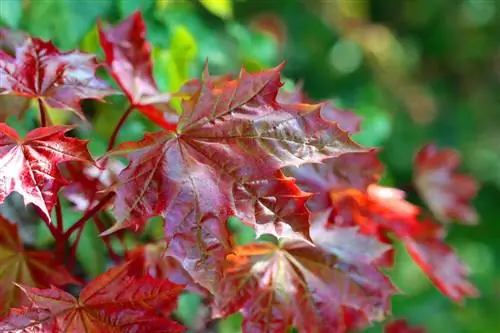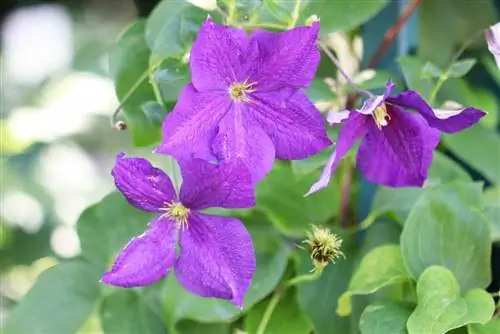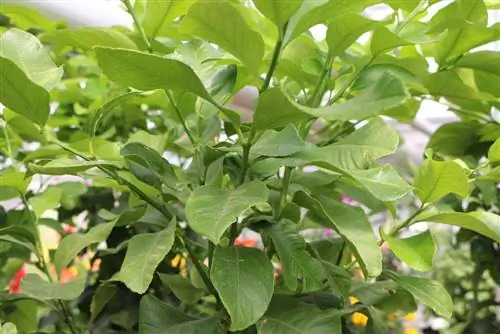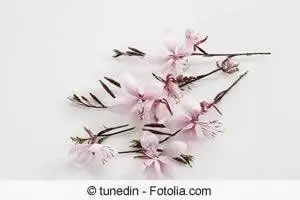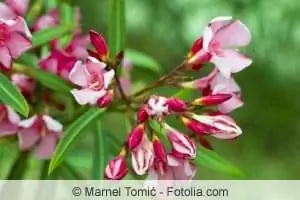- Author admin [email protected].
- Public 2023-12-17 03:39.
- Last modified 2025-06-01 06:48.
The oleander has been bred and offered as a garden and ornamental plant in Central Europe for around 400 years, although this plant originally comes from the Mediterranean region. It is one of the most popular potted plants in Germany, alongside the olive tree, the orange tree, the hemp palm, the passion flower, the hibiscus and the angel's trumpet.
Leaves and flowering time
Oleander leaves are dark green, between 6 and 10 centimeters long and are arranged in groups of three on a branch like a whorl. The umbel flower has five sepals and five petals each and can be seen from June to September. The color of the oleander ranges from white, yellowish to pinkish red and the oldest leaves fall off once they have yellowed. The flowers of the oleander only bloom heavily in summer, while the buds do not develop in cold temperatures. The oleander is pollinated by long-pronged butterflies, which produces fruit capsules up to 15 centimeters long.
Propagation

An oleander propagates through cuttings, with the best propagation time being from June to September. For propagation, only strong shoot tips that do not have flowers should be exposed.
- The shoot tips are cut with scissors or a knife.
- The cuttings are placed in a container filled with water and placed in a shady location.
- The lower shoot tip should be under water by a maximum of 5 centimeters.
- Root formation usually takes around four weeks. As soon as the roots are 1 to 2 centimeters long, they are potted up.
Pests & Diseases
Oleander can be attacked by aphids, scale insects, mealybugs and oleander canker. The aphids should only be controlled with cold-free plant spray. If there is a small infestation of scale insects, they can be controlled with a wet cloth or sponge. If the scale insect infestation is more severe, the control should also be carried out with appropriate plant spray, with the treatment being carried out every three to five days.
Oleander - Location & Care
The botanical name of the oleander is part of its care. The Greek nerium means “moist, wet” and the nickname oleander is derived from the Latin “oleum” for oil. In its original wild form, the oleander occurs in the Mediterranean region on the edges and banks of rivers. This explains the high water requirement of this plant. It has been cultivated as a cultivated plant for around four hundred years and has now become native to the northern regions as far as Helgoland. It is particularly popular as a container plant because of its flowers.

The oleander likes it bright, warm and with plenty of water. Ideally, it should be protected from wind and rain so that it can develop and preserve its full blooms. A parking space on the east side of the house is possible, but not necessarily ideal. The oleander prefers the south and southwest sides because the duration of sunshine and the warmth at the location are the conditions for abundant flowering. The plant needs regular watering, avoiding watering with rainwater. Fertilization is also of particular importance, as the oleander has a high nutrient requirement.
- The oleander thrives best in a good mixture of peat and potting soil.
- Because oleanders grow well with lime water, this plant can also be watered with normal tap water - although rainwater is definitely more suitable.
- The best fertilizer is the complete fertilizer, although blue grain can also be very helpful because it supplies the oleander with additional nutrients for a longer period of time and therefore thrives better.
Cutting oleander
With oleander, trimming is basically not necessary, but older plants should be cut back. It is best to thin out every one or two years, in which the longest and very old shoots are cut back to the old wood. The best time for such a cut is after flowering or before the first snow falls.
Overwintering oleander
Oleander's preferred temperature for overwintering is between 0 and 10 degrees Celsius. It is generally recommended to move the plants into their winter quarters as late as possible, as the climatic conditions and lighting are rarely optimal. Although the oleander can withstand frost down to -5 degrees, there is a risk of frost damage to the plant during longer frost periods or lower temperatures. Depending on the size of the oleander bush, preparations are necessary for overwintering in protected outdoor areas, such as in front of house walls, on terraces or in carports.
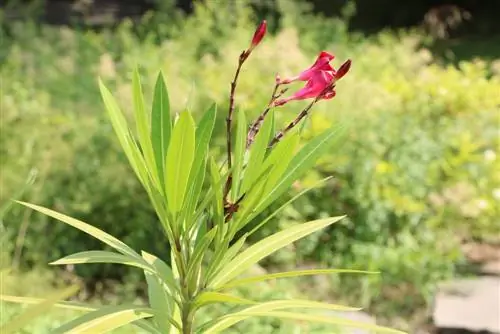
Oleander is not hardy, however, so overwintering outdoors poses risks for the shrub. Alternatives include accommodation in protected but unheated rooms, such as winter gardens, garages, basements or similar. The following applies to wintering:
- as bright a location as possible with daylight
- Ambient temperature between 0 and 10 degrees Celsius
- If the room for wintering is dark, the ambient temperature must also be low
- water only moderately during the rest phase, avoid waterlogging
- regular inspection for pest infestation
- Cut only next spring
- After overwintering, put it in a shady place for a few days
When overwintering outdoors, the following still applies:
- Wind-protected location (not on the weather side!)
- place a thick styrofoam or insulation board under the plant pot
- Wrap the plant pot with jute, bubble wrap or fleece
- additionally pad and insulate the plant pot with straw or leaves
- tie the upper parts of the plant together and wrap them with protective fleece or cover them with hoods
- Remove the plant from its protective covering in frost-free times
Editor’s warning
Due to its extreme toxicity, oleander sap should never get into the mouth or even the eyes, as this can cause headaches, cramps, nausea, cardiac paralysis and skin irritation.


